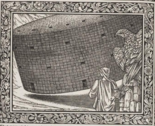Talk:Kelmscott Press
Appearance
The Wikimedia Foundation's Terms of Use require that editors disclose their "employer, client, and affiliation" with respect to any paid contribution; see WP:PAID. For advice about reviewing paid contributions, see WP:COIRESPONSE.
|
A fact from Kelmscott Press appeared on Wikipedia's Main Page in the Did you know column on 23 October 2021 (check views). The text of the entry was as follows:
|
| This article is rated Start-class on Wikipedia's content assessment scale. It is of interest to the following WikiProjects: | |||||||||||||||||||||||||||||||||||||||||
| |||||||||||||||||||||||||||||||||||||||||
Untitled
[edit]Suggest improvements below:
just pasted my work
[edit]Hey, I had been working on a Kelmscott press page for a while, but I probably should stop sitting on it, so thanks for helping me get stuff out there. I'm worried that I've included TOO much detail? I still want to put in a sentence or two about the book of poetry Kelmscott published of the poet that Morris's daughter had a relationship with, but I will focus on a DYK nomination for now. Rachel Helps (BYU) (talk) 17:02, 29 September 2021 (UTC)
- I had been surprised that no standalone article existed about the Press (it certainly seems notable enough!). This inspired me to break out some material from Morris's very long biographical article, but the resulting stub remained much too brief. I'm glad this prompted you to publish your work! I don't think it's too much detail at all for such an important subject, with a large literature to draw from. Thank you for your contribution! Ted Pudlik (talk) 23:42, 22 October 2021 (UTC)
- It seems like Wikipedia has a bit of a gap when it comes to fine presses and printing history, but we are working to make it smaller. I'm glad you liked the page! Rachel Helps (BYU) (talk) 17:11, 25 October 2021 (UTC)
Did you know nomination
[edit]- The following is an archived discussion of the DYK nomination of the article below. Please do not modify this page. Subsequent comments should be made on the appropriate discussion page (such as this nomination's talk page, the article's talk page or Wikipedia talk:Did you know), unless there is consensus to re-open the discussion at this page. No further edits should be made to this page.
The result was: promoted by Theleekycauldron (talk) 02:00, 15 October 2021 (UTC)
( )
- ... that in the Kelmscott Press's acclaimed Complete Works of Chaucer, illustrator Burne-Jones depicts a house "made of twigges" (pictured) in an unusually literal style? Source: "Burne-Jones insisted that he was trying to see Chaucer's poetry afresh, not merely through the eyes of earlier illustrators, and this often led to a peculiar sort of literalism in his interpretation of the text: the example often noticed by readers of the Chaucer is the extraordinary image of the House 'made of twigges' as a large wicker basket in The Hous of Fame." (The Kelmscott Press by William S. Peterson, p. 248)
- ALT1:... that William Morris versified the language of a prose translation of Beowulf and made the language even more archaic for its publication with his Kelmscott Press? Source: "Published in 1895, just one year before his death, Morris’s version of Beowulf was based on a prose translation by a young Cambridge University scholar in Anglo-Saxon, A.J. Wyatt. But Morris reinterpreted this translation into verse format and favoured using deliberately archaic diction that often mirrored the original, perhaps attempting to evoke the strange ancient setting of the original." Cambridge University Library article on Morris's Beowulf
- Reviewed: Zenith Easy PC
5x expanded by Rachel Helps (BYU) (talk). Self-nominated at 19:18, 29 September 2021 (UTC).
 This article replaces a redirect and is new enough and long enough. The image is in the public domain, the hook facts are cited inline and either hook could be used, the article is neutral, and I detected no copyright issues. A QPQ has been done. Cwmhiraeth (talk) 12:54, 6 October 2021 (UTC)
This article replaces a redirect and is new enough and long enough. The image is in the public domain, the hook facts are cited inline and either hook could be used, the article is neutral, and I detected no copyright issues. A QPQ has been done. Cwmhiraeth (talk) 12:54, 6 October 2021 (UTC)
Categories:
- Talk pages of subject pages with paid contributions
- Wikipedia Did you know articles
- Start-Class Harold B. Lee Library-related articles
- Unknown-importance Harold B. Lee Library-related articles
- Harold B. Lee Library-related rare books articles
- Start-Class company articles
- Low-importance company articles
- WikiProject Companies articles
- Start-Class Typography articles
- Mid-importance Typography articles





